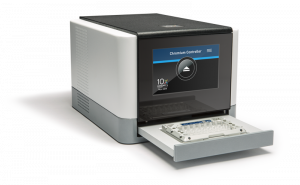
The distribution of LT cells in the G1, G2/M, and S phases. The proportion of reads of genes in the GO:0005576 “extracellular region” term (C), GO:0016020 “membrane” term (D), and GO:0005737 “cytoplasm” term (E) for cells from LT. The total read number of each cell from LT. The schematic diagrams of two scRNA-seq platforms. Both TPM (Smart-seq2) and normalized UMI (10X) are analyzed to detect highly variable genes (HVGs), which are often used for either cellular phenotype classification or new subpopulation identification. The number of unique molecular identifiers (UMIs) is considered as a direct presentation of gene expression level. By contrast, 10X is a droplet-based scRNA-seq technology, allowing genome-wide expression profiling for thousands of cells at once. Reads mapped to a gene are used to quantify its abundance in every cell, and transcripts per kilobase million (TPM) is a common metric of expression normalization. Smart-seq2 is based on microtiter plates, , where mRNA is separated and reverse transcribed to cDNA for each cell. Smart-seq2 and 10X Genomics Chromium (10X 10X Genomics, Pleasanton, CA) are two frequently-used scRNA-seq platforms ( Figure 1A). With the improvement of sequencing technologies, scRNA-seq is becoming robust and accessible for transcriptome analysis. Compared with RNA-seq of bulk tissues with millions of cells, scRNA-seq provides an opportunity to analyze the composition of tissues/organs and the diversity of cellular states, as well as to detect rare cell types. Our study promotes better understanding of these two platforms and offers the basis for an informed choice of these widely used technologies.Īfter firstly introduced in 2009, single-cell RNA sequencing (scRNA-seq) has dramatically influenced research fields ranging from cancer biology, stem cell biology to immunology,. In addition, each platform detected distinct groups of differentially expressed genes between cell clusters, indicating the different characteristics of these technologies. However, 10X-data can detect rare cell types given its ability to cover a large number of cells. 10X-based data displayed more severe dropout problem, especially for genes with lower expression levels. Approximately 10%−30% of all detected transcripts by both platforms were from non-coding genes, with long non-coding RNAs (lncRNAs) accounting for a higher proportion in 10X.

For 10X-based data, we observed higher noise for mRNAs with low expression levels. The composite of Smart-seq2 data also resembled bulk RNA-seq data more. Smart-seq2 detected more genes in a cell, especially low abundance transcripts as well as alternatively spliced transcripts, but captured higher proportion of mitochondrial genes. Here, by directly comparing the scRNA-seq data generated by these two platforms from the same samples of CD45 − cells, we systematically evaluated their features using a wide spectrum of analyses. The droplet-based 10X Genomics Chromium (10X) approach and the plate-based Smart-seq2 full-length method are two frequently used scRNA-seq platforms, yet there are only a few thorough and systematic comparisons of their advantages and limitations. Single-cell RNA sequencing (scRNA-seq) is generally used for profiling transcriptome of individual cells.


 0 kommentar(er)
0 kommentar(er)
